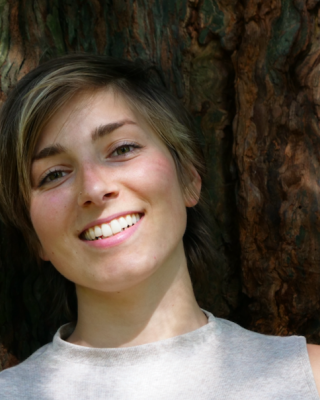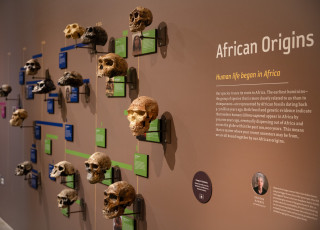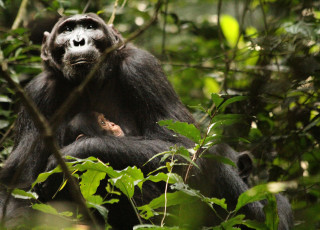The Importance of Getting Lunch in Human Evolution
NOTE: Kristen Hawkes will discuss how food is woven into humans’ emergence in her presentation, “The Importance of Getting Lunch in Human Evolution,” during the Utah Food Festival on Sunday, May 5, at 2:30 p.m.
By Jude Coleman
Our evolutionary story is a complicated one. The history of scientists attempting to unravel it is filled with shifting theories and evidence, changing as new fossils and genetic information are uncovered. We know that modern humans evolved from an ancestor we share with great apes in Africa, and genetic evidence shows that chimpanzees and bonobos are our closest living relatives in the evolutionary tree of life. From the most recent common ancestor, we share with them some descendants include our own genus Homo. Our emergence comes from a confluence of climate change in ancient Africa, ancestral populations drawn to new resources and natural selection. But many details of this journey are still unknown.
In other words, “How’d we get to be this ape?” asks evolutionary anthropologist Kristen Hawkes. Hawkes is an anthropology professor at the University of Utah who studies how humans arose and what sets us apart from our closest living relatives.
Throughout her work, Hawkes has found that broad evolutionary comparisons are crucial to understanding our evolution. We are on the mammal branch of that tree of life, on a primate branch of that mammal branch, and on the great ape branch of the primates. Knowing those relationships explains many things about us. She takes advantage of those comparisons and what she’s learned from living with modern people who know how to depend on wild foods. One glaring difference between humans and other mammals, including our great ape cousins is how and when babies rely on their mothers.
In all mammals, babies reach a point where milk alone isn’t enough to sustain their growth — they need to add solid food. Although other great ape babies generally continue to nurse for several years, they start to supplement their mother’s milk with solid food after a few months. Babies start grabbing their own food on the go while their mothers carry them along, reaching out to snatch nearby fruit or bugs just as she is doing. And by the time infants are weaned, they fill their food needs entirely on their own.
Now, contrast that with a human baby. Although they can start to eat solid foods at around six months old and may finger-feed themselves, they still rely on their caregivers to put the bite-sized food bits in front of them. It takes several more years before a child can toddle to a food source (in this case, maybe the pantry) and procure a snack. “[It’s] a creature clearly unable to forage to feed itself,” Hawkes said. She thinks that some of the secrets to our evolution are hiding in this difference between us and apes: we need someone else to supply our lunch.
At NHMU’s 2024 Food Festival, Hawkes will discuss how food is woven into humans’ emergence in her presentation, “The Importance of Getting Lunch in Human Evolution.” The presentation will take place on Sunday, May 5, at 2:30 p.m. in the Community Room.
No one knows exactly when and why the divide in babies’ self-sufficiency began. Hawkes agrees with others who think a big driver for it was likely ancient climate change. Our great ape relatives live in tropical forests, which, millions of years ago, covered more of Africa’s landscape. The tropical forests became fragmented as the climate began to change before the Pleistocene around 2.6 million years ago — shifting from warm and wet to cool and dry. Between the forests were swaths of savannas and grasslands. While some of our common ancestors with the living African apes stayed in the forests or on its fringes, some hominid ancestors began migrating into the savanna. Food sources in the forests were likely accessible for youngsters to find and grab, as we see great ape babies continue to do now; but foraging was trickier in the savanna. Instead of low-hanging fruit and invertebrate-filled logs, there were tubers and big game. While hunting was a high-risk, high-reward food source, tubers would have been more consistent, providing a foundation of sustenance. Unfortunately, they are deeply buried, out of reach for little fingers. That meant that children, let alone babies, wouldn’t have a food source if adults couldn’t provide it. Hawkes thinks there’s strong evidence for a link between that shift in babies’ food reliance and some of our uniquely human features.
“How we got to have this life history turned out to account for a whole array of features that distinguish us from the other great apes,” she said. For example, humans are highly social animals, a behavior that begins in babyhood. In other apes, mothers deliver a baby every four to five years, and by the time they do, the previous one can acquire its own food. In contrast, human birth intervals can be much shorter, on the order of just a couple of years. We “stack” dependent offspring, and this human tendency to have the next offspring sooner would likely be favored by natural selection only if the previous toddler was likely to survive. Hawkes explained that this is where grandmothers likely played a role. A grandmother hypothesis links the evolution of our short birth spacing and our long span of non-childbearing years.
Hawkes saw the grandmother hypothesis in action during her fieldwork in Africa while spending time with the Hadza community in Tanzania. Here, Hawkes followed women in the community as they foraged and compared their success with children’s weights. At first, the children’s weight was correlated with their mother’s foraging. But after a new sibling was born, it switched to correlating with their grandmother’s foraging.
Even more human traits could have rippled out from the impacts of the grandmother hypothesis, such as longer developmental periods and larger brains. A cascade of evolutionary events, all with ties, somehow, to food, Hawkes said. “It all comes back to what you are depending on for food and the whole issue of getting lunch.”
Learn more during Kristen Hawkes' presentation, “The Importance of Getting Lunch in Human Evolution,” during the Utah Food Festival on Sunday, May 5, at 2:30 p.m.




